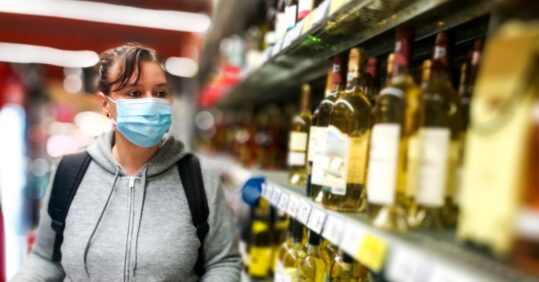Supporting people with problematic drinking during Covid

A colleague joked with me that during full Covid lockdown people either got fit, put on weight, or turned to drink. We all have different ways of coping with stress and change. This year has been a time of change in all our lives. Uncertainty has been in our minds throughout and we have all had to adjust and learn to cope with new challenges.
Related Article: ‘Patients not prisoners’: Palliative care nursing behind bars
In my dual diagnosis role, providing advice and consultation on those who have a co-occurring mental health and substance use disorders, I was all too aware that those with problematic drinking were perhaps more at risk during Covid. In the worst-case scenarios, one could envisage them becoming ill with Covid-19, withdrawing from drinking and suffering greatly or potentially worse. My concerns were around those who relied on psychosocial groups to draw on the support of others, and offer their own support to others (an underestimated power of group work). How would services react to and cope with this change and how would mental health and substance misuse services be able to respond?
My fears were perhaps confirmed with statistics from April and May 2020 highlighting that the frequency of people using alcohol had increased by over 50% and the amount consumed each session had increased by over 25% (Trans-European Covid lockdown & drugs survey by NEWnet and TEDI partners).
Our dual diagnosis network discussed this regularly and we helped shape and form new ways of working. Face-to-face contact reduced dramatically (only the most urgent cases were seen and full PPE was required) and we mourned for what we would lose. Practitioners have a whole repertoire of skills to look for signs that may raise our suspicions of when someone’s drinking has increased, or something’s not right. Some of these are obvious, other signs are more nuanced, individualised, and personal to that individual; relapse signatures that have been learned over time. Staff can become accomplished at spotting these signs, sometimes even before the person themselves. Stressful situations would be considered one of these nuances, as you know we react in different ways – the same applies to the people we support. So in addition to the uncertainty in our own lives, frontline mental health and substance misuse practitioners geared themselves up to performing much of their role blindfolded, unable to rely on their years of skill and experience. This has been a challenge in particular for mental health and substance misuse services whereby routine face-to-face visits have been all but been put on hold unless there were increased concerns. It’s worth asking ourselves whether our services have been as adept at maintaining face-to-face contact where others have been able to adapt and maintain this contact facing similar infection risks?
Related Article: New film spotlights health visitor role in supporting fathers’ mental health
Recognising emerging issues during Covid has required skill contortion, not reliant on the usual face-to-face. Staff from mental health and substance misuse services tell me about the increased importance of ‘therapeutic curiosity’. As well as asking people directly about their alcohol use practitioners reflect on other questions they ask themselves and others. Is there a change in conversation, is speech slurred, has engagement reduced? Does the person they are supporting talk about relapse triggers and warning signs, do they reflect on the impact of Covid on their mental health and drinking, and how are their support networks holding up?
Where there may have been caution, there has also been innovation, creativeness and responsiveness, in a manner I have not seen before. Services moved swiftly. I’ve observed ways staff have attuned their skills to phone/video contact work and less face to face. I see teaching sessions about how to use phones/video conferencing to those where this is a barrier. I’ve seen reaching out to other services, checking with others, or family members (with permission) a real multi agency approach, a demonstration of best practice. If there has been an absence of contact an agreed protocol to visit has been put in place or in some cases police welfare checks are made.
Related Article: Domestic violence has long-term impact on mental health
At the same time it’s worth highlighting that for some, telephone contact is actually easier than getting to a base and bearing your soul to strangers and in these cases engagement has actually increased. Yes, I know for others they miss the face-to-face, yet sitting in your own home meeting your buddies online for a Zoom-based tea and toast group I’m sure would’ve been a great way to feel connected. I’ve heard about Zoom quiz groups, increased daily phone checks for those most at risk. I’ve also heard staff normalise the jagged process of recovery in context of what’s happened over the phone and just listen – in my view showing kindness and empathy over the phone requires an increased level of skill. In lots of ways service approaches have become more person-centered, offering support on what works for that individual – I may have mentioned we are all different but isn’t this what we should have always done? I may just be being Covid positive but my hope is that when all this is over, services reflect and draw on their new-found skills of engagement and personal approaches and offer a wider variety that suits each person.

See how our symptom tool can help you make better sense of patient presentations
Click here to search a symptom




